前言
我所理解的上下文是一种具有承上启下作用的对象,例如:对外获取资源,对内管理、分配资源。那么协程上下文的职责又是什么呢?本文是《深入理解Kotlin协程》的读书笔记之一,是我对Kotlin协程上下文的一些理解。
CoroutineContext是什么
协程上下文定义在kotlinx-coroutine-core中:
1 | public interface CoroutineContext { |
从CoroutineContext暴露的接口来看:
CoroutineContext重写了[]和+这两个操作符;- 支持根据给定的
Key减去某个CoroutineContext; - 支持fold操作,将当前的
CoroutineContext‘折叠’成类型为R的结果;
这么看来似乎CoroutineContext更像一个容器类型,并且还引入了Key和Element这两个未知的概念。我们不妨继续看CoroutineContext还定义了什么:
1 | public interface CoroutineContext { |
从上面的代码可以看出:
- 一个
Key对应一个Element; Element又实现了CoroutineContext;
结合上面的信息,我对CoroutineContext就有了一个大致的印象:它是一个以Key为主键,以Element为值的集合。
但是有一点比较奇怪,哪有对象即是元素本身,也是一个集合的,这不是矛盾了吗?阅读了相关代码后,发现这并不矛盾,分情况讨论:
CoroutineContext是一个元素
如果CoroutineContext是集合的一个元素,那这个CoroutineContext必然实现了CoroutineContext.Element接口。
例如协程调度器CoroutineDispatcher、协程拦截器ContinuationInterceptor和协程名CoroutineName等;以协程名为例:
1 | public data class CoroutineName( |
除了key以外,其他均使用了Element的默认实现。这很符合常识,毕竟此时的CoroutineContext是一个元素,只需要比较key,以决定进一步的操作。
CoroutineContext也是一个集合
如果CoroutineContext是一个集合,那它的实现必定是CombinedContext:
1 | internal class CombinedContext( |
从定义来看,CoroutineContext类似于集合的递归定义,大致的结构如图所示:

既然是集合,必定重新实现了CoroutineContext关于集合修改的方法:
get方法
既然是一个集合,那很自然的就想到了线性查找。查看实现,确实如此,从右至左查找:
1 | internal class CombinedContext(...) { |
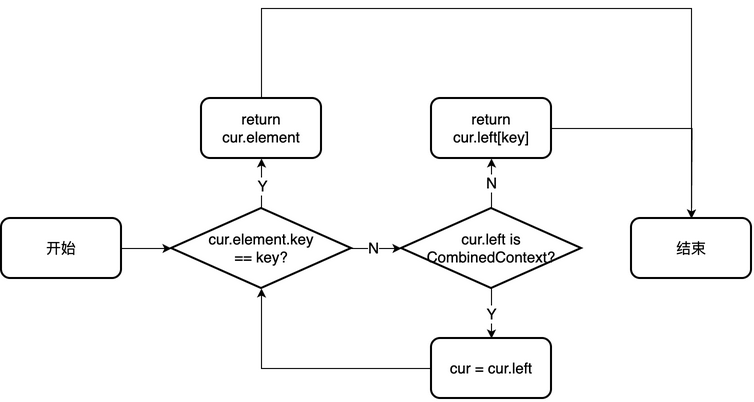
minusKey方法
minusKey方法,顾名思义就是根据给定的Key删除集合中的对应元素。看代码会首先判断最右边的元素,如果key相同,则保留左支;否则在左支线性搜索。处理好做减法后集合不变和集合变空这两种边界情况,剩下的就是一般的情况——返回一个新的CombinedContext。
1 | internal class CombinedContext(...) { |
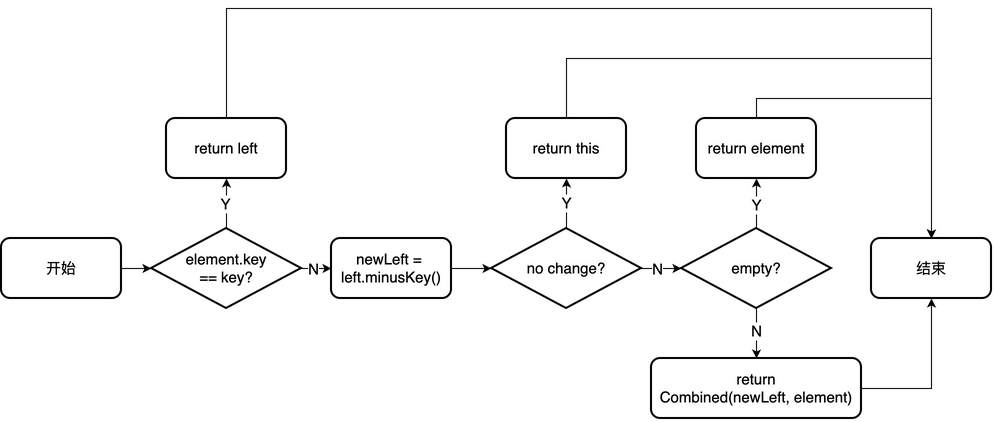
plus方法
CombinedContext并没有重写plus方法,而是使用了CoroutineContext的默认实现。因为要保证拦截器处于上下文的最右边以方便快速取到拦截器,所以默认实现稍显复杂。
虽然plus方法较为复杂,但其本质还是重写了+操作符。+操作符的左右边都是CorouinteContext,可以是CoroutineContext.Element和CombinedContext。因为加法是从左至右的,所以分为三种情况(使用[]代表CombinedContext,最右边即为element字段):
存在空集合EmptyCoroutineContext
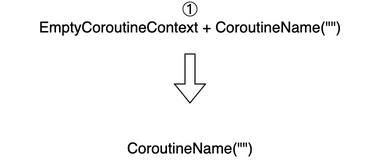
Element + Element

因为一个上下文中拦截器有且仅有一个,所以默认实现是后来的覆盖前面的(情况③),且拦截器必定在上下文的最右边。
CombinedContext + Element

拦截器的覆盖如情况⑤,结果也必定是拦截器在最右边。
CoroutineContext结构既是List也是Map
CoroutineContext既像List一样具有线性接口,也能像Map一样根据key来获取对应的value。为什么这么设计?
- 如果
CoroutineContext只是一个List,我们需要获取对应的类型的上下文时,需要通过index线性查找,最后再通过泛型进行强转;1
2
3
4
5val elements: List<Element>
inline fun <reified E: Element> get(): E? {
return elements.find { it is E } as? E
} - 如果
CoroutineContext只是一个Map,我们需要在获取对应类型的上下文后,手动再进行强转;1
2
3
4
5
6
7
8
9val elementMap: Map<Key<out Element>, Element>
fun get(key: Key<out Element>): Element? {
return elementMap[key]
}
// 这么调用
val coroutineDispatcher =
coroutineContext[CoroutineDispatcher] as? CoroutineDispatcher
但如果结合List和Map的特点,上面两个问题便迎刃而解。
小结
CoroutineContext既可以是集合的元素,也可以是集合本身,其表现形式分别是CoroutineContext.Element和CombinedContext。类图如下:
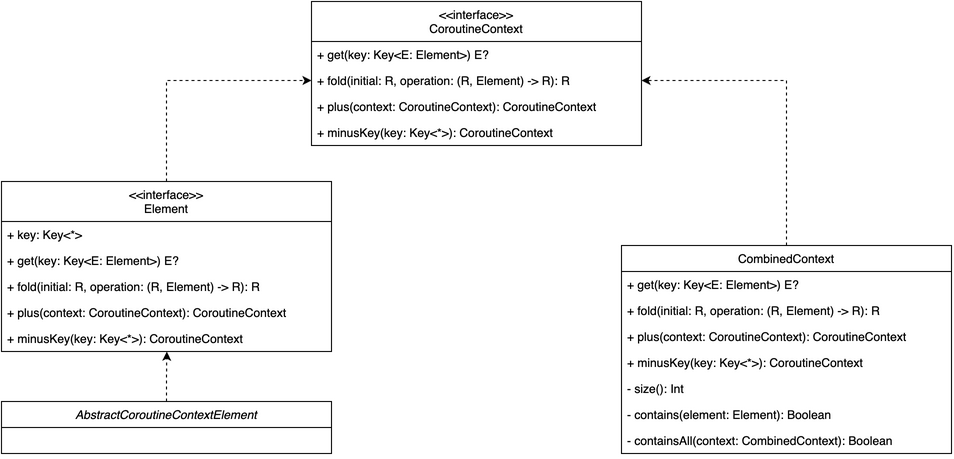
同时,为了方便搜索,CoroutineContext被设计成了Indexed Sets的数据结构——既有List的线性结构,也有Map的键值对结构。
CoroutineContext的元素
阅读完上文,我们知道原来CoroutineContext是一个线性键值对集合结构,那这个集合必定有多种元素。主要的元素与CoroutineContext的关系如下: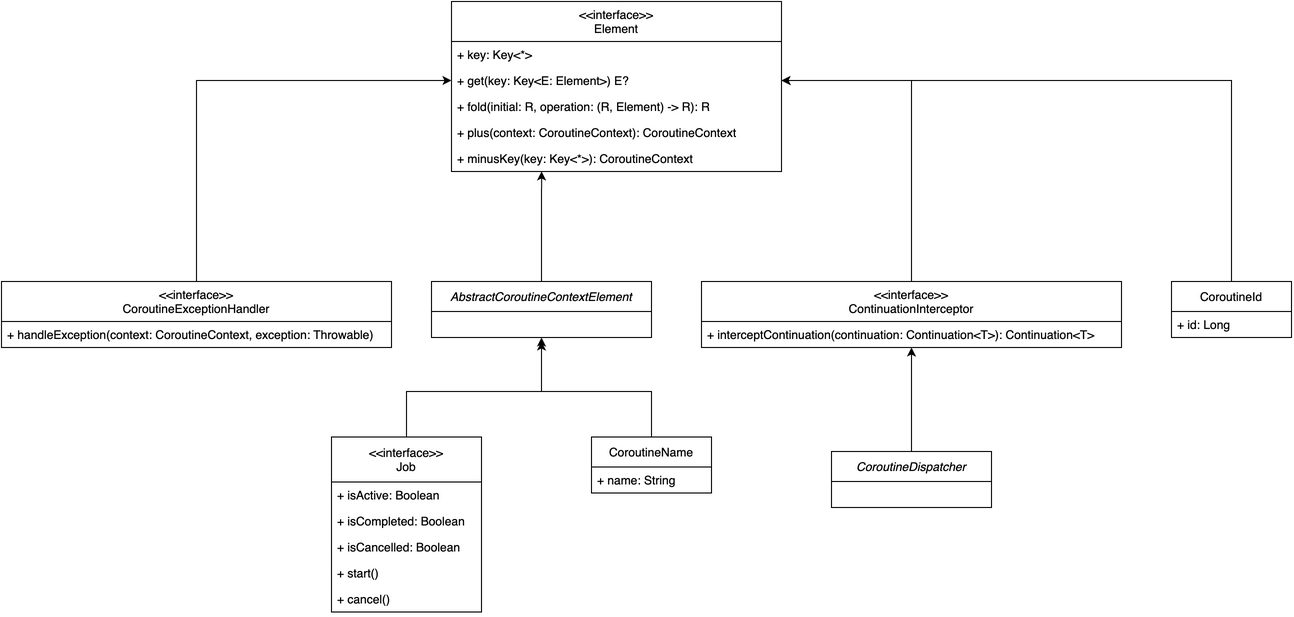
ContinuationInterceptor
CoroutineContext的元素有协程拦截器:ContinuationInterceptor。顾名思义,协程拦截器是是用于拦截协程的。如果你对协程有大致的了解,就会知道Kotlin协程本质还是回调,其表现形式就是Continuation:
1 | public interface Continuation<in T> { |
这里的resumeWith就是成功接口和失败接口的合体,当协程从挂起转向恢复状态的时候会调用这个方法。而协程拦截器的本质就是Wrapper模式:将旧有的Continuation包装成新的Continuation:
1 | public interface ContinuationInterceptor : CoroutineContext.Element { |
这种Wrapper模式可以帮我们做很多事,比如在协程恢复的时候切换线程:
1 | class ContinuationInterceptorImpl<T>( |
Kotlin的协程已经帮我们实现好了——协程调度器CoroutineDispatcher
CoroutineDispatcher
CoroutineDispatcher是协程调度器,它会在协程恢复时决定要不要切换线程和切换到哪个线程执行。其原理如上所描述,在协程恢复时决定是否帮我们切线程和切哪个线程:
1 | public abstract class CoroutineDispatcher : ..., ContinuationInterceptor { |
可以看到CoroutineDispatcher实现了协程拦截器,在拦截协程时,interceptContinuation返回了一个DispatchedContinuation,本质还是Wrapper模式:
在恢复的时候,检查是否需要切线程,即CoroutineDispatcher.isDispatchNeeded,如果需要就调用CoroutineDispatcher.dispatch切换,否则就直接恢复协程。
Kotlin协程已经内置好了多个协程调度器,供开发者使用:
1 | public actual object Dispatchers { |
| 调度器 | 含义 |
|---|---|
| Dispatchers.Main | 主线程调度器,协程恢复时切换到主线程 |
| Dispatchers.Default | 默认调度器,协程恢复时切换到默认线程池的线程 |
| Dispatchers.IO | IO线程调度器,协程恢复时切换到IO线程池的线程 |
| Dispatchers.Unconfined | 协程恢复发起方在哪个线程,协程恢复时就在哪个线程执行 |
Job
Job也是协程上下文之一,用于描述协程执行状态、层级关系的一类上下文:
1 | public interface Job : CoroutineContext.Element { |
- start和cancel用于扭转协程的状态;
- isActive,isCompleted,isCancelled用于描述协程的状态;
- children用于描述层级关系,即协程的父子关系;
CoroutineContext的本质
我所理解的CoroutineContext,其本质就是“全局”的公共集合,作为协程执行过程中一些必要元素的存取容器:
- 协程(挂起后)恢复时,用
CoroutineDispatcher把线程环境切回来; - 协程完成、取消或异常了,用
Job来扭转协程的状态,并根据父子协程的关系传递事件或者异常; - 协程执行的过程中出现异常了,使用
CoroutineExceptionHanlder来处理; - 为了方便追踪,用
CoroutineName给协程起个名字;
而这个“全局”,即为作用域:
1 | public interface CoroutineScope { |
如果脱离作用域来启动一个协程,相当于这个协程没有了上下文,也就丧失了上面所说的几种能力。
所以标准库中定义的启动协程函数,是以CoroutineScope为receiver的:
1 | fun CoroutineScope.launch(...): Job { ... } |
所以,CoroutineContext的职责为:在作用域下提供协程执行过程中存取必要元素的能力。
总结
CoroutineContext是一个Indexed Set的数据结构,既有List的线性结构,也有Map的键值对结构。
每个协程作用域都有一个CoroutineContext,它为协程执行的过程中提供一个存取必要元素的容器。
这些元素服务于协程的执行——有负责在挂起后恢复时切换线程环境的CoroutineDispatcher,也有描述协程执行状态与层级结构的Job,也有负责处理协程执行过程中出现的异常的CoroutineExceptionHandler,等等。
其本质就是作用域下公共元素的存储集合。